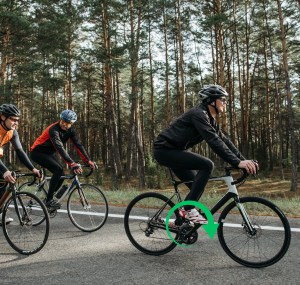All forms of motion produce energy. Whenever you exercise or actively move around, your body has and uses up stored energy from eating food and resting. One of the best ways to get your body going and to use this energy is through biking.
However, what type of energy is riding a bike? Actually, it’s the typical example of kinetic energy.
Cycling often features three energy types, often acquired through energy conversions and transformations. There’s muscular, heat, and mechanical energy.
Table of Contents
What Type of Energy is Riding a Bike
When an individual rides a bike, they convert most of their potential energy into motion. This bicycle energy transformation often occurs in pedaling wherein you are using several kinds of energy to pedal and put the bike in motion.
By exerting force and using one’s potential energy, the bicycle undergoes energy transformation and produces different kinds of energy.
1. Muscular energy
Exercise and fitness are often a big part of riding a bicycle. Any energy exerted by a person through the energy stored in their body is muscular energy. There are two types of this particular form of energy: Aerobic and Anaerobic energy.
Aerobic energy comes from performing a moderate-level movement. The body fuels this energy with oxygen. Exercises that require steady movement, walking, and leisure biking are all examples of this energy system.
Anaerobic energy, meanwhile, does not require much oxygen. This type of energy comes from high-intensity exercise. Competitive biking or pedaling at high speeds produces this energy system.
2. Mechanical energy
Mechanical energy is the energy in objects that gives the capability to do work. Putting motion onto a bike or any mechanical creation or positioning it at rest produces mechanical energy. It has two kinds of energy.
Kinetic energy is produced through the motion of any object or organism. It commonly transforms into heat, energy, and even sound. Through kinetic energy, the bicycle is able to move continuously.
Potential energy is stored energy at rest. It manifests in the bike itself and the cyclist when they are not moving. These energies are used or burned off to create heat and kinetic energy.
3. Thermal and heat energy
Thermal energy contributes to the energy biking transformation that occurs in the cyclist as well as the bike itself. It is produced through friction and deals with how heat is distributed in different systems across the bike and the body of the cyclist.
Heat energy is also produced while riding a bike. It helps the body burn off excess energy, fat, and calories while riding a bike.
Through heat, the body perspires and regulates the cyclist’s temperature. It also promotes water intake to avoid dehydration or heat-related accidents while cycling.
How Riding a Bike Utilizes Different Types of Energy
Riding a bike efficiently uses up several kinds of energy. When at rest and in preparation, potential energy is used. Energy is restored and replenished to prepare for the long ride.
Once fueled, the biker adapts to a certain energy system its body uses. They can use either aerobic, for a steadier and moderate ride that’s fit for leisure and everyday commute, or anaerobic which uses intense movements and energy.
When either of the two is applied when the biker begins to pedal, kinetic and heat energy is slowly produced. The kinetic energy moves the bicycle, while also producing thermal energy.
Heat energy allows the cyclist to burn off calories while moving while also developing air resistance while the bike is on the move.
Once the bicycle comes to a halt, the friction that compels the bike and the cyclist to stop creates thermal energy between the road and the tires. All the friction and kinetic energy present can also create sound from the bike.
Benefits of Cycling for Energy
There are several advantages catered to the environment and the cyclist when riding a bike instead of taking a car.
1. Reduces air pollution and protects biodiversity.
Riding a bike instead of using cars is a better alternative, to reduce greenhouse gases and promote healthier surroundings.
2. Helps with fitness.
Exercising by riding bikes can burn off fat in different areas of your body and promote fitness. Overall, biking is a great exercise for a healthier lifestyle.
3. Increases energy levels.
Cycling helps boost energy levels during. The energy cycling transformation helps you feel refreshed and energized as soon as you wake up and helps effectively send signals to your brain to produce more energy.
4. Saves time and money.
By commuting on a bike, you can efficiently save money by not spending too much on cars or public transport. Biking can also save you time by getting you to your destination quickly.
Tips for Efficient and Sustainable Biking
To conserve energy and be more considerate of the environment and your lifestyle, here are a few ways:
- Be informed
Know more about the area you’ll bike in. It will save you time in locating certain areas and help you avoid disturbing the environment, especially when biking in forests.
- Never litter, clean as you go
Littering can be a problem when on the go. Remember not to just throw anything away and dispose of waste in proper bins.
- Repair and upgrade your bike instead of replacing it.
Rather than spending too much on a new bike, check on your current one. You can upgrade or repair it instead to avoid wasting it.
- Use sustainable products when biking.
Some materials in clothes and food can be harmful to you and the environment. Try opting for sustainable products that can help you stay healthy and protect your surroundings.
Conclusion
What type of energy is riding a bike? It’s a question that answers and gives knowledge beneficial for both one’s health and the environment’s welfare. To put it simply, there are different types of energy used in riding a bike.
Biking creates different types of energy from both the cyclist and the bike itself. It doesn’t just serve as a rigorous and ideal workout but is also good for energy conservation and sustainable living.

“I ride my bike to work for years, but is that enough? Our carelessness towards our surroundings has taken a toll on the environment. And now, everyone is responsible for changes; even the most minor contribution is counted. With this hope and spirit, I started with my partner to establish Biketoworkday to help more individuals commute to their work sites on their bikes.”











